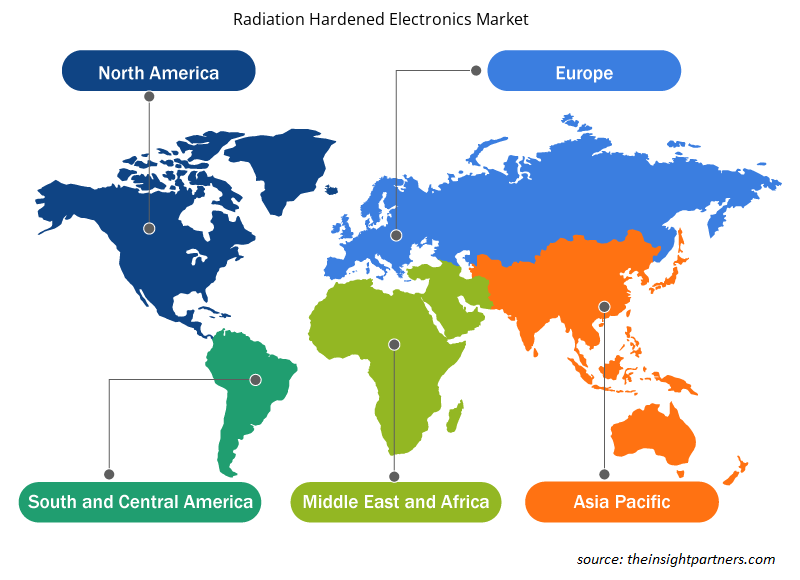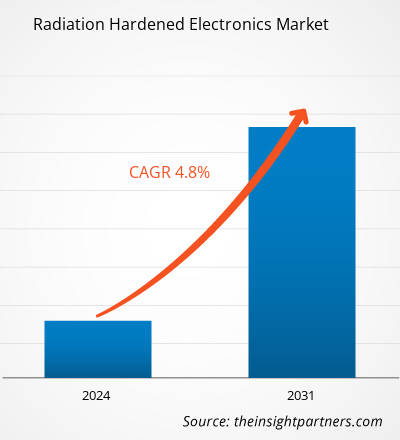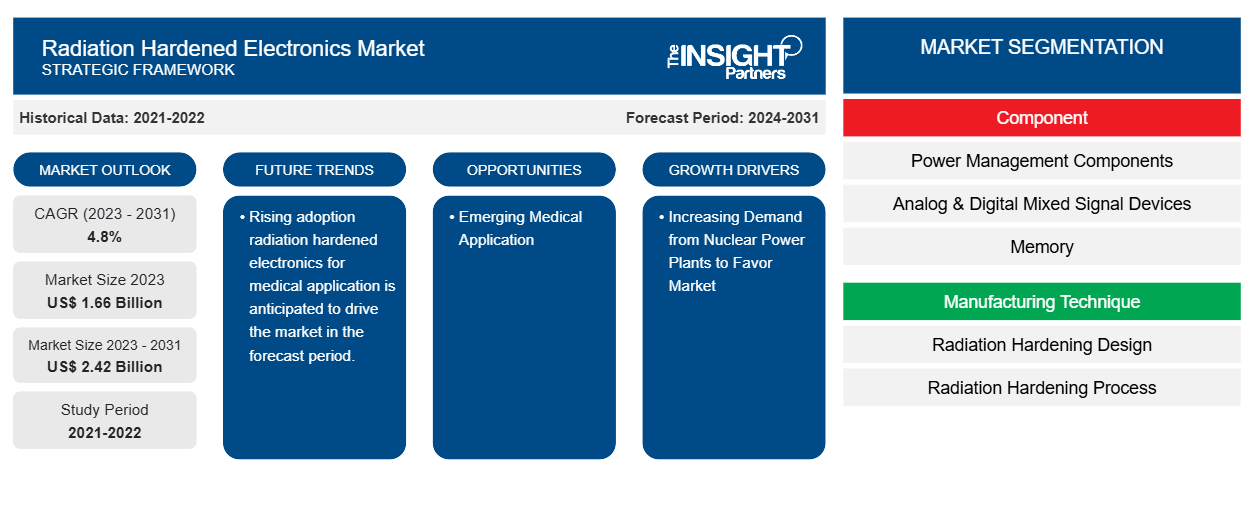Si prevede che la dimensione del mercato dell'elettronica indurita dalle radiazioni raggiungerà i 2,42 miliardi di dollari entro il 2031, rispetto agli 1,66 miliardi di dollari del 2023. Si prevede che il mercato registrerà un CAGR del 4,8% nel periodo 2023-2031. È probabile che l'adozione crescente di elettronica indurita dalle radiazioni e l'aumento degli investimenti nei programmi spaziali rimangano tendenze e driver chiave nel mercato.
Analisi del mercato dell'elettronica resistente alle radiazioni
Si prevede che la crescente domanda di sensori di feedback resistenti alle radiazioni tra i produttori di apparecchiature e sistemi critici in tutto il mondo stimolerà il mercato dei sensori di feedback resistenti alle radiazioni durante il periodo di previsione. I sensori di feedback resistenti alle radiazioni sono ampiamente integrati nei sistemi aerospaziali e di difesa, veicoli spaziali, satelliti, sonde spaziali, apparecchiature mediche e altri. I progressi tecnologici, la miniaturizzazione dei sensori di feedback resistenti alle radiazioni, la crescente domanda di energia rinnovabile e le crescenti attività di R&S stanno spingendo il mercato dei sensori di feedback resistenti alle radiazioni.
Panoramica del mercato dell'elettronica resistente alle radiazioni
I sensori di feedback resistenti alle radiazioni sono dispositivi progettati per resistere a livelli elevati di radiazioni, più comunemente riscontrati in ambienti nucleari e spaziali. Questi sensori impiegano un meccanismo di feedback per monitorare costantemente le loro prestazioni e si regolano di conseguenza, assicurando operazioni affidabili e accurate in radiazioni intense. I sensori utilizzano loop di feedback per rilevare eventuali deviazioni dal comportamento previsto causate da danni indotti dalle radiazioni.
Personalizza questo report in base alle tue esigenze
Riceverai la personalizzazione gratuita di qualsiasi report, comprese parti di questo report, o analisi a livello nazionale, pacchetto dati Excel, oltre a usufruire di grandi offerte e sconti per start-up e università
- Scopri le principali tendenze di mercato in questo rapporto.Questo campione GRATUITO includerà analisi di dati che spaziano dalle tendenze di mercato alle stime e alle previsioni.
Driver e opportunità del mercato dell'elettronica resistente alle radiazioni
La crescente domanda di centrali nucleari favorisce il mercato
Le centrali nucleari sono coinvolte nella generazione di elettricità attraverso il processo di fissione nucleare. In questo processo, viene prodotta una notevole quantità di energia, che genera una notevole quantità di radiazioni. Questa radiazione è dannosa per gli esseri umani e può danneggiare le apparecchiature elettroniche, aumentando la domanda di sensori di feedback resistenti alle radiazioni. I sensori di feedback resistenti alle radiazioni sono posizionati strategicamente in tutto l'impianto per monitorare le variazioni di temperatura in aree critiche, come i sistemi di raffreddamento, il nocciolo del reattore e vari componenti. Questi sensori forniscono un feedback continuo ai sistemi di controllo, consentendo agli operatori dell'impianto di adottare le misure necessarie per mantenere l'intervallo di temperatura desiderato e prendere decisioni informate per migliorare le prestazioni del sistema. Diverse aziende stanno effettuando investimenti significativi nello sviluppo di centrali elettriche. Ad esempio, secondo i dati del Dipartimento dell'energia degli Stati Uniti (DOE) pubblicati a gennaio 2024, il DOE ha investito circa 12 miliardi di dollari nell'impianto Vogtle per fornire alla rete oltre 1.100 megawatt di energia pulita una volta in funzione.Vogtle to provide more than 1,100 megawatts of clean power to the grid once in operation.
Applicazione medica emergente.
I sensori di feedback resistenti alle radiazioni svolgono un ruolo cruciale nel garantire la sicurezza, l'accuratezza e l'affidabilità delle apparecchiature mediche utilizzate nel settore sanitario. Questi sensori sono integrati in una varietà di apparecchiature mediche, tra cui raggi gamma, raggi X e fasci di elettroni, rendendoli resistenti a livelli elevati di radiazioni. I sensori di feedback resistenti alle radiazioni sono principalmente integrati nelle apparecchiature per radioterapia per supportare i medici nel trattamento dei pazienti oncologici. La radioterapia , nota anche come radioterapia, è la modalità di trattamento più comune per i pazienti oncologici, in cui vengono utilizzati fasci di radiazioni ad alta energia per colpire e distruggere le cellule cancerose, che richiedono sensori di feedback resistenti alle radiazioni per monitorare vari parametri, tra cui somministrazione della dose, densità del fascio e posizionamento del fascio. Gli operatori sanitari utilizzano sensori di feedback resistenti alle radiazioni per garantire la somministrazione di un trattamento accurato e preciso riducendo al minimo i danni ai tessuti sani. Ad esempio, nell'aprile 2022, Maxon Group ha introdotto gli encoder ENX GAMA progettati per l'uso in prossimità di acceleratori lineari medici su apparecchiature come i collimatori multi-lama. Gli encoder ENX GAMA sono encoder resistenti alle radiazioni integrati con motori CC altamente adatti per dispositivi di radioterapia.Maxon Group introduced ENX GAMA encoders designed for use in the vicinity of medical linear accelerators on equipment such as multi-leaf collimators. ENX GAMA encoders are radiation-resistant encoders integrated with DC motors that are highly suitable for radiotherapy devices.
Analisi della segmentazione del rapporto di mercato dell'elettronica indurita dalle radiazioni
I segmenti chiave che hanno contribuito alla derivazione dell'analisi del mercato dell'elettronica resistente alle radiazioni sono i componenti, le tecniche di produzione e le applicazioni.
- In base al componente, il mercato dell'elettronica indurita dalle radiazioni è suddiviso in componenti di gestione dell'alimentazione, dispositivi a segnale misto analogici e digitali, memoria e controller e processori. Si prevede che il segmento dei componenti di gestione dell'alimentazione detenga una quota di mercato significativa nel periodo di previsione.
- In base alla tecnica di produzione, il mercato dell'elettronica indurita dalle radiazioni è suddiviso in indurimento dalle radiazioni per progettazione (RHBD) e indurimento dalle radiazioni per processo (RHBP). Si prevede che il segmento dell'indurimento dalle radiazioni per progettazione (RHBD) deterrà una quota di mercato significativa nel periodo di previsione.
- Per applicazioni, il mercato è segmentato in aerospaziale e difesa, centrale nucleare, spazio e altri. Si prevede che aerospaziale e difesa manterranno una quota di mercato significativa nel periodo di previsione.
Analisi della quota di mercato dell'elettronica resistente alle radiazioni per area geografica
L'ambito geografico del rapporto sul mercato dei dispositivi elettronici resistenti alle radiazioni è suddiviso principalmente in cinque regioni: Nord America, Asia Pacifico, Europa, Medio Oriente e Africa, e Sud e Centro America.
Il Nord America ha dominato il mercato dell'elettronica resistente alle radiazioni. L'industria spaziale in espansione sta potenziando il mercato dei sensori di feedback resistenti alle radiazioni in Nord America. Gli Stati Uniti sono stati in prima linea nei voli spaziali per oltre 60 anni. Hanno il più grande programma spaziale governativo al mondo. I satelliti registrati negli Stati Uniti hanno rappresentato oltre la metà di tutti i satelliti operativi nel 2022. Gli Stati Uniti sono attualmente l'unico paese con un account tematico per le attività spaziali. Inoltre, una forte enfasi sulla ricerca e sviluppo nelle economie sviluppate di Stati Uniti e Canada sta costringendo gli attori nordamericani a portare sul mercato soluzioni tecnologicamente avanzate. Inoltre, gli Stati Uniti hanno un gran numero di attori del mercato dell'elettronica resistente alle radiazioni che si sono sempre più concentrati sullo sviluppo di soluzioni innovative. Tutti questi fattori contribuiscono alla crescita del mercato dell'elettronica resistente alle radiazioni nella regione.
Approfondimenti regionali sul mercato dell'elettronica resistente alle radiazioni
Le tendenze regionali e i fattori che influenzano il mercato dell'elettronica indurita dalle radiazioni durante il periodo di previsione sono stati ampiamente spiegati dagli analisti di Insight Partners. Questa sezione discute anche i segmenti e la geografia del mercato dell'elettronica indurita dalle radiazioni in Nord America, Europa, Asia Pacifico, Medio Oriente e Africa e America meridionale e centrale.

- Ottieni i dati specifici regionali per il mercato dell'elettronica resistente alle radiazioni
Ambito del rapporto di mercato sui prodotti elettronici resistenti alle radiazioni
| Attributo del report | Dettagli |
|---|---|
| Dimensioni del mercato nel 2023 | 1,66 miliardi di dollari USA |
| Dimensioni del mercato entro il 2031 | 2,42 miliardi di dollari USA |
| CAGR globale (2023-2031) | 4,8% |
| Dati storici | 2021-2022 |
| Periodo di previsione | 2024-2031 |
| Segmenti coperti | Per componente
|
| Regioni e Paesi coperti | America del Nord
|
| Leader di mercato e profili aziendali chiave |
|
Densità degli attori del mercato: comprendere il suo impatto sulle dinamiche aziendali
Il mercato dell'elettronica resistente alle radiazioni sta crescendo rapidamente, spinto dalla crescente domanda degli utenti finali dovuta a fattori quali l'evoluzione delle preferenze dei consumatori, i progressi tecnologici e una maggiore consapevolezza dei vantaggi del prodotto. Con l'aumento della domanda, le aziende stanno ampliando le loro offerte, innovando per soddisfare le esigenze dei consumatori e capitalizzando sulle tendenze emergenti, il che alimenta ulteriormente la crescita del mercato.
La densità degli operatori di mercato si riferisce alla distribuzione di aziende o società che operano in un particolare mercato o settore. Indica quanti concorrenti (operatori di mercato) sono presenti in un dato spazio di mercato in relazione alle sue dimensioni o al valore di mercato totale.
Le principali aziende che operano nel mercato dell'elettronica protetta dalle radiazioni sono:
- Sistemi BAE
- Società di dispositivi dati
- Honeywell International Inc.
- Infineon Technologies AG
- Società di elettronica Renesas
- Società per azioni Texas Instruments
Disclaimer : le aziende elencate sopra non sono classificate secondo un ordine particolare.

- Ottieni una panoramica dei principali attori del mercato dell'elettronica resistente alle radiazioni
Notizie e sviluppi recenti sul mercato dell'elettronica resistente alle radiazioni
Il mercato dell'elettronica indurita dalle radiazioni viene valutato raccogliendo dati qualitativi e quantitativi dopo la ricerca primaria e secondaria, che include importanti pubblicazioni aziendali, dati di associazioni e database. Di seguito sono elencati alcuni degli sviluppi nel mercato dell'elettronica indurita dalle radiazioni:
- EPC Space ha presentato l'EPC7009L16SH, un IC driver di gate in nitruro di gallio (GaN) indurito dalle radiazioni. Utilizzando l'esclusiva tecnologia IC eGaN di EPC, questo innovativo driver GaN consente ai progettisti di sfruttare appieno le capacità della tecnologia FET eGaN. (Fonte: EPC Space, sito Web aziendale, aprile 2024)
- Renesas Electronics Corporation, fornitore di soluzioni avanzate per semiconduttori, ha lanciato una nuova linea di dispositivi resistenti alle radiazioni (rad-hard) incapsulati in plastica per sistemi di gestione dell'alimentazione satellitare. I quattro nuovi dispositivi includono il regolatore buck point of load (POL) ISL71001SLHM/SEHM, gli isolatori digitali ISL71610SLHM e ISL71710SLHM e il FET GaN da 100 V ISL73033SLHM e il driver low-side integrato. (Fonte: Renesas Electronics Corporation, sito Web aziendale, luglio 2021)
Copertura e risultati del rapporto sul mercato dell'elettronica indurita dalle radiazioni
Il rapporto "Dimensioni e previsioni del mercato dell'elettronica indurita dalle radiazioni (2021-2031)" fornisce un'analisi dettagliata del mercato che copre le seguenti aree:
- Dimensioni e previsioni del mercato dell'elettronica protetta dalle radiazioni a livello globale, regionale e nazionale per tutti i principali segmenti di mercato interessati dall'indagine.
- Tendenze del mercato dell'elettronica protetta dalle radiazioni e dinamiche di mercato quali fattori trainanti, limitazioni e opportunità chiave.
- Analisi dettagliata delle cinque forze PEST/Porter e SWOT.
- Analisi del mercato dell'elettronica protetta dalle radiazioni che copre le principali tendenze del mercato, il quadro globale e regionale, i principali attori, le normative e i recenti sviluppi del mercato.
- Analisi del panorama industriale e della concorrenza che copre la concentrazione del mercato, l'analisi della mappa di calore, i principali attori e gli sviluppi recenti per il mercato dell'elettronica protetta dalle radiazioni.
- Profili aziendali dettagliati.
- Analisi storica (2 anni), anno base, previsione (7 anni) con CAGR
- Analisi PEST e SWOT
- Valore/volume delle dimensioni del mercato - Globale, Regionale, Nazionale
- Industria e panorama competitivo
- Set di dati Excel
Report recenti
Testimonianze
Motivo dell'acquisto
- Processo decisionale informato
- Comprensione delle dinamiche di mercato
- Analisi competitiva
- Analisi dei clienti
- Previsioni di mercato
- Mitigazione del rischio
- Pianificazione strategica
- Giustificazione degli investimenti
- Identificazione dei mercati emergenti
- Miglioramento delle strategie di marketing
- Aumento dell'efficienza operativa
- Allineamento alle tendenze normative





















 Ottieni un campione gratuito per - Mercato dell'elettronica resistente alle radiazioni
Ottieni un campione gratuito per - Mercato dell'elettronica resistente alle radiazioni